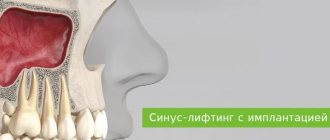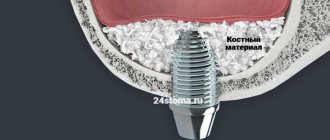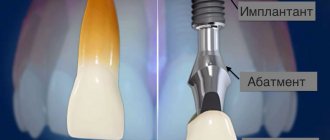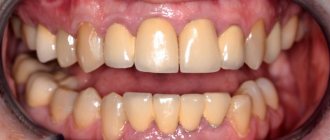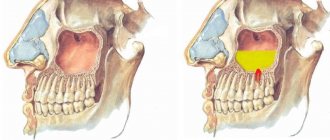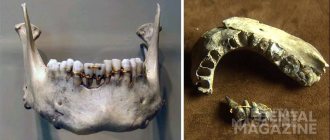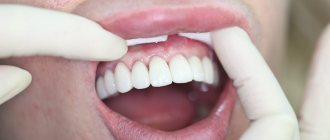What is a sinus lift?
Sinus lifting (sinus floor elevation) is a procedure for increasing bone tissue in the area of the maxillary sinuses. They are located on the upper jaw to the left and right of the nose. In most people, the roots of the chewing teeth of the upper jaw are initially located in the maxillary sinuses, so after the removal of these teeth there is not enough bone tissue to install an implant. Closest to the maxillary sinuses are the molars (sixth and seventh teeth), less often the premolars (fourth and fifth teeth), and sometimes the canines.
The orthopantomogram shows the boundaries of the bottom of the maxillary sinuses and the apex of the alveolar ridge. There is not enough bone tissue to install implants.
Indications
To install an implant, a minimum of 10 mm of bone tissue is required to the maxillary sinus. Otherwise, a rise in its bottom is shown.
1) If the distance to the sinus is 8-10 mm, it is possible to perform a closed sinus lift with simultaneous installation of implants. The term “closed” means that no additional incisions are required. This can be compared to endoscopic operations. The postoperative period is easier.
2) If there is bone tissue from 5 mm to 8 mm, an open sinus lift (classic version) is performed with simultaneous installation of implants. This technique creates access to the maxillary sinus from the cheek. Its mucous membrane is peeled off, lifted, and bone-substituting material is placed in the resulting space, which is absorbed and replaced with its own bone.
3) If the distance to the maxillary sinus is less than 5 mm, an open sinus lift is performed without installing implants. For immediate installation of implants, a sufficient volume of bone tissue is required in which they will be stabilized. If it is not enough, then the bone volume is first increased. After 6-9 months, implants are installed. After another 6 months, crowns are installed on the implants. With severe atrophy of bone tissue in the upper jaw, the treatment period can be more than a year.
Bone Augmentation Methods
According to statistics, sinus lifting is necessary for 8 out of 10 patients requiring implantation. But insufficient tissue volume makes it impossible to screw in titanium pins. What to do? A sinus lift will help, which is by far the most effective and safe way to build bone. There are other methods: bone autotransplantation, regeneration, splitting of the alveolar process. But the sinus lift is the most common choice: it is used in 70% of cases. The main advantage of the operation is its versatility. It has few contraindications, is easier to tolerate than others, and has excellent success rates. At the same time, a sinus lift not only increases the size of the jaw to the desired figures, but also strengthens the tissues, contributing to the overall health of the oral cavity. Of the remaining 30 percent, approximately equal portions are accounted for by the 3 bone augmentation methods.
- Autotransplantation - materials taken from the patient are used to increase height. This ensures excellent survival rate and a painless postoperative period. After only 5–6 months, the bone becomes a monolith, ready for the insertion of pins and implantation.
- Directed regeneration – third-party biomaterials are used to increase volume. They can be taken from the patient's own chin area or placed by a donor - a process called allografting. Sometimes xenotransplantation is carried out - in this case, the raw materials have to be borrowed from animals, most often from domestic pigs.
- Alveolar ridge splitting is a simple but rather painful option. Using an incision, an implant is inserted into the appendix, and the free space is filled with the patient’s biomaterial. By creating a protective membrane, it becomes possible for tissue expansion. The gum is stitched back together and implantation can be done after six months.
ON A NOTE! The latter method is used most often to fill voids after cyst removal. Splitting the appendix makes it possible to clean the internal areas and carry out a complete sanitation of the oral cavity. Hard tissue augmentation in this way is also used during the treatment of periodontitis.
Contraindications
In addition to general contraindications (type 1 diabetes, recent radiation therapy, etc.), there are a number of factors that may carry additional risks for the operation. The most common limitation is inflammatory diseases in the maxillary sinus area. It is necessary to identify the source of inflammation. Additional consultation with an ENT specialist may be required. Some difficulties may be due to previous operations in the area of the maxillary sinuses.
Open
The first step is to numb the surgical site. Local anesthesia, as for dental treatment. The procedure itself is painless.
At the second stage, an incision is made in the gum in the area of the missing teeth. The gum itself moves upward, exposing the underlying bone tissue. Then access to the maxillary sinus is created. With the help of special instruments, the wall of the maxillary sinus is thinned, limiting it from the oral cavity. The inside is lined with mucous membrane (Schneiderian membrane). During surgery, the mucous membrane peels off and rises.
Bone replacement material is placed in the resulting space, which eventually dissolves and is replaced by its own bone.
Despite the apparent complexity of the procedure, open sinus lift has several advantages. It is possible to significantly increase the volume of bone in the maxillary sinus area, even in cases where the distance to it is only 1 mm. The operation is performed under direct vision control, so the implant surgeon can take into account all anatomically complex areas and avoid complications, for example, rupture of the mucous membrane of the maxillary sinus.
Open sinus lift with immediate installation of implants.
Standards for sinus lifting in our Center
Regardless of the method used to perform sinus lift, we did everything possible to ensure that the operation was successful without complications. For all types of surgical operations, incl. and for sinus lifting, our Center provides a lifetime guarantee.
We have eliminated the risks of possible errors at each stage of the operation:
- Ultrasound protocol PiezoSurgery® Piezosurgery is the standard of modern dentistry. When creating access to the maxillary sinus, the bone is not sawed out, drilled or broken out, but is delicately softened. The Center uses the NSK VarioSurg device, which turns off when approaching soft tissues - nerves, blood vessels, sinus mucosa. Which eliminates ruptures, perforations and perforations.
- Operating microscope All stages of the operation are performed under multiple magnification of a Seiler dental microscope. Increases visibility of the surgical field, helps the surgeon see even the finest structures, visually control actions in the smallest detail to avoid deviations from the standard protocol.
- Lift-Control Micro Instrument Set To work with the Schneiderian membrane (sinus lining), a coordinated set of instruments are used in a specific sequence. This allows the surgeon to most delicately and carefully separate the membrane from the bone plate without tearing or damaging it.
- Bone growth stimulants We use only original certified bone replacement drugs, which are completely biocompatible and do not cause allergies or rejection. KEYSTONE's protein and collagen bone morphogenetic proteins (BMPs) stimulate bone tissue growth using the body's reserve forces.
Sinus lifting with sedation - comfort for anxious patients and salvation for heart patients
We perform the operation in medicated sleep. Immersion in a controlled sleep allows you to undergo a necessary but exciting procedure without pain, fear and nervous overload. This is especially important for patients with cardiovascular diseases to avoid pressure surges. Our staff anesthesiologist-resuscitator will select the optimal “cocktail” of sedatives and condition-correcting drugs. After the operation, you will not be haunted by dizziness and clouding of consciousness - this is not general anesthesia . The drugs are completely safe for the body, after 30-40 minutes you can go home. We will not keep you in the clinic unnecessarily; hospitalization for 2-3 days is not required.
Levin Dmitry Valerievich
Founder and Chief Doctor of the Center
Closed
Unlike the open one, the closed version is carried out only simultaneously with the installation of implants. The gum incision is the same as for conventional implantation.
First, preparations are made for implant installation. A bed for the implant is formed. Then a special instrument is installed through it, it is called an osteot, with the help of which the bottom of the maxillary sinus is raised. After raising the bottom, the implant is installed.
The advantages of this method are the minimal invasiveness of the procedure and an easier rehabilitation period. However, in this case it is possible to raise the bottom of the sinus only by 2-3 mm. If you try to perform a closed sinus lift with a fundus elevation of 4-5 mm, there is a risk of rupture of the mucous membrane of the Schneiderian membrane.
First, a bed is formed for installing the implant. Through it, the bottom of the maxillary sinus is raised. The procedure involves one-stage installation of implants.
Implantation without sinus lift
Many well-known brands of implants have reconsidered their position regarding bone grafting and are offering solutions that allow the installation of implants without additional operations to build up bone tissue. When the bone volume is insufficient, it is possible to install a shorter implant without performing a sinus lift.
Straumann offers implants with a length of 4 mm. According to studies, the length of the implant does not matter if the installation protocol is followed. Thus, it is possible to avoid additional surgical procedures by installing a shorter implant.
This approach has its limitations, and in all clinical cases it is not possible to install implants without osteoplasty. If a large number of teeth are missing, it is possible to install extreme implants at an angle of up to 45 degrees, bypassing the maxillary sinuses. Implants of the required length are installed without bone tissue augmentation. Read more about this technique in the article about All-on-4.
The distance to the maxillary sinus is 7 mm. Instead of performing a sinus lift, a short Ankylos implant (Germany) 6.6 mm long was installed without additional surgical procedures.
Are there any alternative solutions?
The need for a sinus lift does not arise in all cases. It will not be required if dental restoration is carried out using basal implantation technology, which uses a special type of implants.
There is no need for a sinus lift when using All-on-4 implantation technology. But there is one caveat: surgery according to this protocol is applicable only to patients with a completely toothless jaw.
Would you like to receive detailed advice on sinus lifting from qualified and experienced specialists? Come to an appointment with the doctors at our clinic in Moscow - “Aesthetica”! The initial consultation with a specialist is free and during the consultation you will receive detailed answers to all your questions about dental implantation.
To make an appointment, you just need to dial our clinic’s phone number or leave a request for a call back on our website.
Take a short test and calculate the cost of treatment!
Take a short test
- Selection of implants
- Which tooth is missing?
- How long has the tooth been lost?
- Missing teeth
- Cost calculation
×
Manukyan Artavazd Genrikovich
Chief physician of the clinic
Articles on the topic
What tests to take before dental implantation in Moscow
The necessary tests for dental implantation are determined individually after the initial examination.
The doctor takes into account the condition of the oral cavity and the presence of concomitant chronic diseases...... Read #dental implantation
Nobel implants – Nobel Biocare, turnkey price, reviews, installation
Nobel implants are developments of the Swiss manufacturer Nobel Biocare, celebrating their half-century anniversary.
Biocare is rightfully considered one of the leading implant manufacturers. Nobel products….. Read #dental implantation
Turnkey dental implantation: description of the procedure, features and benefits for patients
Implantation is a modern and effective method of restoring lost teeth.
During the operation, the patient is implanted in the area of the lost tooth with an implant - an artificial root, onto which it is then fixed..... Read #dental implantation
Implantation of chewing teeth: subtleties of the process, technology, prices
We will tell you about implantation of chewing teeth in this article.
After reading the material, you will learn about the features of implantation of chewing teeth, what implants and crowns are needed….. Read
Rehabilitation period
On the day after surgery, pain is possible, which can be relieved by taking anti-inflammatory painkillers (Nurofen, Nice, Nimesil). Starting from the next day, the need for painkillers is much less, 1-2 tablets per day for 2-3 days is enough. Swelling may occur in the surgical area. The swelling increases for 3 days, and begins to subside on the fourth. Therefore, it is not recommended to heat the surgical site or engage in physical labor for several days after a sinus lift. Nasal congestion may occur, which can be relieved with vasoconstrictor nasal drops. To prevent complications, it is recommended not to fly on an airplane for 1-2 weeks after osteoplastic surgery. This is due to the pressure difference in the plane, which theoretically can lead to a violation of the integrity of the mucous membrane of the maxillary sinus.
If a sinus lift was carried out with the immediate installation of implants, then on average after 6 months crowns are installed on them. If there was large atrophy of bone tissue, and the operation was performed without installing implants, then the waiting period is 6-9 months.
Possible complications
Sinus lifting of the upper jaw is safe if it is performed by a specialized dentist in a clinic with the necessary equipment. However, in some cases, negative consequences may occur both during the operation itself and during the rehabilitation period:
- perforation of the maxillary sinus;
- pushing the implant into the sinus;
- development of acute sinusitis, which, if left untreated, can become chronic;
- poor fastening, mobility of the structure;
- wound infection;
- bleeding from the nose or wound;
- implant rejection.
Immediately after the procedure, swelling, pain, and redness of the mucous membranes occur. Body temperature may increase. These phenomena go away on their own after a few days. To alleviate the condition, you can take analgesics, antipyretics, and rinse your mouth with antiseptics.
If infection or damage to soft tissue occurs, complications become apparent within the first 3 days. If the temperature rises, pain or swelling increases, you should consult a doctor.
What bone replacement materials are used in sinus lifting?
The reference material for sinus lifting is the patient’s own bone. It has maximum regenerative potential and absolute biocompatibility. However, to get your own bone you need to get it from somewhere. This is the disadvantage of this method, because... it is more traumatic. In addition to surgery in the maxillary sinus area, it is necessary to perform a second operation to obtain your own bone tissue. Most often it is obtained from the angle of the lower jaw, or from the chin area.
There are bone replacement materials that give a similar result as the patient’s own bone. They are produced in the form of granules and are obtained from the bones of cattle, or are completely synthesized. These are absolutely safe materials, the most famous of them is called Bio Oss from the Swiss company Geistlich. The mechanism of action of bone replacement materials is that they create the basis for the germination of one’s own blood vessels and cells. Over the course of 6-9 months, bone replacement materials gradually dissolve, being completely replaced by the patient’s own newly formed bone.
Platelet Rich Plasma
To stimulate the growth of the patient's own bone, PRP technology is used - platelet rich plasma - platelet rich plasma. Before the sinus lift begins, a test tube of blood is taken from a vein. It is placed in a centrifuge, in which it is separated into fractions within 12 minutes, one of which is platelet-rich plasma. Using this method, it is possible to obtain bone growth factors. Unlike collecting your own bone, which also contains growth factors, obtaining a tube of venous blood is much easier. By using the patient's own blood, the risks of incompatibility and allergic reactions are eliminated.
Postoperative period
Very often after surgery there is swelling that lasts for 10-14 weeks. It should be remembered that swelling is a completely normal reaction of the body to surgical trauma, and it does not in any way affect the effectiveness of the intervention.
Healing of the gums usually takes 5-7 days, after which the sutures are removed. But doctors’ recommendations and some restrictions should be strictly followed for another 3-4 weeks to avoid displacement of the bone material and its secondary infection. So, you should refrain from smoking, air travel, and lifting heavy objects. You should not drink through a straw, actively blow your nose, and it is recommended to cough and sneeze with your mouth open, covering it with a napkin.
Over more than 30 years of practice, sinus lift technology has shown its effectiveness. This operation makes implantation possible in the most severe and seemingly hopeless cases.
Various techniques
One of the most common complications is rupture of the maxillary sinus membrane. It occurs during an open sinus lift, when access to the maxillary sinus is created, or during its membrane peeling. Therefore, burs and cutters have been developed that do not injure the membrane of the maxillary sinus even if they accidentally touch it.
Another option is an endoscopic sinus lift . It is carried out without additional incisions, like a closed one, but with its help you can significantly raise the bottom of the maxillary sinus. With the usual closed version, monitoring the condition of the membrane is carried out only tactilely, therefore, using this method, the bottom of the sinus does not rise more than 2-3 mm. But under the visual control of an endoscope, it is possible to expand the indications and conduct a closed sinus lift even in cases where an open one is indicated.
The main advantages of the endoscopic method are low trauma and an easy postoperative period. Only a few clinics have the necessary expensive equipment to carry out such a procedure.
Preparing for surgery
Before the operation, the surgeon carefully examines the bones of the upper jaw on a CT scan and the location of the maxillary sinus on an X-ray. Before the operation, dental plaque is cleaned and sometimes, if chronic sinusitis is suspected, antibiotics are prescribed two days in advance to avoid cross-infection during the procedure. Smokers are given replacement therapy (the operation does not require a temporary cessation of smoking, but life is more comfortable with replacement therapy).
Read more about preparation here.
How to avoid risks and complications?
Although the sinus lift has been used worldwide for over 30 years, it is a technically challenging procedure. Additional complications may arise from anatomical formations in the maxillary sinus, for example, septa dividing the sinus into several cells. The membrane can be so thin that it ruptures during a sinus lift from a banal exit through the nose.
How to avoid health risks if you are indicated for a sinus lift? The main thing is to trust a qualified implantologist who will take the correct treatment tactics even in a difficult case. Be prepared for the fact that the treatment period for severe bone tissue atrophy can be significant, a year to a year and a half.
The best bone grafting is the one that doesn't take place. If it is possible, without compromising the reliability of the treatment plan, to avoid bone grafting, then you can install shorter implants or bypass the maxillary sinus by installing implants at an angle.
Sinus lift and sinusitis
Often people accidentally find out that they have problems with the maxillary sinus. This usually happens during a routine examination at the dentist, when an orthopantomogram is taken for another issue and the doctor notices in the image that the mucous membrane of the maxillary sinus is thickened.
What to do in this case? No need to panic. There are many reasons for thickening of the maxillary sinus membrane, and not all of them require any additional treatment. The simplest thing is that the picture was taken at a time when the patient was infected with ARVI. A cold can cause the lining of the maxillary sinus to thicken as the body's response to illness. It is necessary to repeat the picture some time after complete recovery, and only then can conclusions be drawn.
In any case, it is recommended to obtain additional advice from an ENT specialist who will accurately determine the nature of the thickening of the maxillary sinus membrane. In the absence of inflammatory phenomena, there are no contraindications for surgery. Otherwise, an additional course of treatment for the maxillary sinuses may be required.
Sinus lifting under local anesthesia, general anesthesia or sedation
Any bone grafting is in most cases performed under local anesthesia. Sinus lifting is no exception, but in some situations it is necessary to change the type of anesthesia in the direction of increasing the analgesic effect.
For local anesthesia, the most modern and safe painkillers are used. Sometimes sedatives are added to anesthesia if the patient is terrified of the procedure or is prone to strong feelings. The main problem with such medications is the risk of an allergic reaction. Some groups of patients must undergo a small and painless skin test before administering the product, which helps to exclude intolerance. If the reaction to a provocative test is positive or questionable, then the doctor refuses the incompatible anesthetic and selects a compatible one.
Sinus lifting can be performed under general anesthesia, especially for open surgery. Such anesthesia is required for patients with an excessive gag reflex and people with contraindications to local anesthesia. General anesthesia is also performed during operations in hospitals, if hospitalization is required, or at the request of the patient, if he is afraid of surgery.
Price
The price of a sinus lift consists of the work of the implantologist, as well as the cost of bone replacement materials.
The average cost of a sinus lift is 30-70 thousand rubles.
A closed sinus lift, especially with a slight elevation of the bottom of the maxillary sinus, can be performed without the use of additional bone replacement materials.
| Expert, author of the article: Akhtanin Alexander Pavlovich Orthopedic dentist, implantologist 35 years of implantation experience Material updated: October 11, 2022 |
The essence of the procedure
After the removal of the upper teeth, weakening and thinning of the bone tissue occurs. The lower edge of the maxillary sinuses is located next to the tooth roots, so if they are absent, the bottom descends to the bone. As a result of these two changes, it becomes impossible to secure a dental implant without damaging the soft tissue of the inside of the nose. In addition, the bone becomes fragile and cannot provide reliable fixation of the structure.
With the help of a sinus lift operation, both problems are solved - the thinned bone acquires the required volume, and the bottom of the maxillary sinus is raised due to the augmented material. This can be autologous bone (the patient’s biomaterial) or artificial bone fillers. The second option is more often performed, since it is less complex and painful. Depending on the characteristics of osteoplasty, implantation is carried out immediately or after a period of time.

